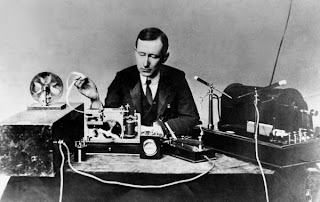The invention of amplifying vacuum tubes was one of the main things that helped to move the radio from military use to civilian use in the mid-1920's. When the government allowed civilians to broadcast on the airwaves after World War I, many radio stations were formed across the United States.
In 1920, the first news program was broadcast over the radio from Detroit, Michigan, station 8MK. This program covered the results of the local election. Later that year, the first United states commercial radio station, KDKA was established, in Pittsburgh, Pennsylvania and in 1922, the first entertainment programs were broadcast on the radio. In 1923, Los Angeles radio station, KHJ, broadcast the Rosebowl for the very first time.
More and more Americans were buying radios and by 1938, four out of five homes had a radio. During World War II, the radio helped to keep up the morale of the country and to keep up to date with the latest happenings of the war. The radio was always a great source for news, but during the troubled and worrisome days of the war, the radio helped to ease that burden a bit.
There were five major networks that were popular during the golden age of radio. These stations were:
National Broadcasting Company (NBC)
Columbia Broadcasting System (CBS)
Mutual Broadcasting System
Armed Forces American Forces Radio Service
American Broadcasting Company (ABC)
The networks were broadcasting live throughout the 1930's and early 1940's because the recording techniques up until that time, just weren't any good. It wasn't until the 1940's, when magnetic wire started being used for recording, which was more cost effective and had better sound quality. Very soon after, magnetic tape recording took over as the main way to record shows for the radio because of the ease in editing this type of medium. Most of these shows though, were delivered to local radio stations on a 33 1/2 rpm vinyl phonograph record.
Many recordings that have survived today are re-recordings of the vinyl phonograph records onto reel-to-reel or cassette tape recordings. Much of the noise, change in quality and other defects is the natural degradation of the materials that the collector had available at the time to record on. It is very hard to find original tapes of radio shows because this tape could be reused and recorded over.
The soap opera began in the 1930's, with the serial, Clara, Lu and Em. Most radio serials that ran a continuing story targeted housewives as the main audience. These show were 15 minute shows that ran in the daytime hours and were sponsored by cleaning products. Thus, the name soap opera was derived.
Musical shows were very popular, as were comedies, featuring the top vaudeville stars and comedians of the time. Anything that was considered entertainment was tried out on the radio, from films to Broadway plays to comic strips being adapted for this medium. Many great radio programs were broadcast during these years. Be sure to check out, http://oldtimeradiolover.com for many of the best shows from the Golden Age of Radio.

The peak of the Golden Age of Radio was in the 1930's. Other venues of entertainment actually scheduled around popular radio shows, otherwise, no one would fill their seats. The radio shows that were produced had to take the listener into the show by relying on sound effects. These old time radio programs used some very innovative ways to get the sound they needed. Check out this video to see the behind the scenes of an old time radio show.
Many of the radio programs that were written during the golden age of radio were became classics and were really the pioneers of television entertainment. Much of the success of the television resulted from using the same formats that those old time radio shows used. In the 1950's, the popular radio shows of the day, successfully moved to the small screen and continued on.
Radio continued to thrive after the Golden Age, but it became mostly a medium for music, news and sports. When rock and roll began in the 1950's, the radio had a huge part in its success. FM radio became popular for music in the 1960's because there was less static and provided a much better quality of sound. All cars come standard with a radio and although there is now satellite radio that people can purchase, FM radio is still thriving and AM radio has become known for talk shows.





.jpg)




